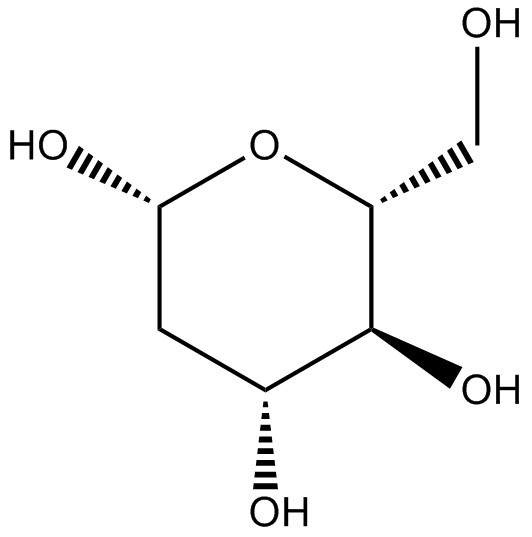2-Deoxy-D-glucose (Synonyms: 2-DG) |
| Catalog No.GC17430 |
2-Deoxy-D-glucose (2DG), is a glucose analogue, act as competitive glycolytic inhibitor.
Products are for research use only. Not for human use. We do not sell to patients.

Cas No.: 154-17-6
Sample solution is provided at 25 µL, 10mM.
2-Deoxy-D-glucose (2DG), is a glucose analogue, act as competitive glycolytic inhibitor [1].
2-Deoxy-d-glucose (2DG) has been demonstrated to be a powerful agent for blocking and probing increased sugar metabolism in cancer cells [2]. Because of its similarity to glucose, 2-Deoxy-D-glucose inhibits glycolysis, but as chemically it is also 2-deoxymannose it is able to compete with mannose in the growing lipid-linked oligosaccharide chain during the initial steps of N-linked glycosylation. This mannose-like property of 2-Deoxy-D-glucose results in misfolded proteins leading to endoplasmic reticulum (ER) stress [3].
2-Deoxy-D-glucose delivered in the diet produces cardiac toxicity in rats at doses ranging from 0.02 to 0.3 g/kg (0.04-0.6% 2-Deoxy-D-glucose by weight in the diet) and hastens mortality at doses above 0.2 g/kg (0.4% in the diet) [4]. 2-Deoxy-D-glucose evoked increases in plasma adrenaline and glucose at 20 and 60 min [5].
References:
[1]. MÜhlenberg T, Grunewald S, Treckmann J, et al. Inhibition of KIT-glycosylation by 2-deoxyglucose abrogates KIT-signaling and combination with ABT-263 synergistically induces apoptosis in gastrointestinal stromal tumor[J]. PloS one, 2015, 10(3): e0120531.
[2]. El Mjiyad N, Caro-Maldonado A, Ramirez-Peinado S, Munoz-Pinedo C. Sugar-free approaches to cancer cell killing. Oncogene. 2011 Jan;30(3):253-64.
[3]. Kurtoglu, Metin, Johnathan C. Maher, and Theodore J. Lampidis. "Differential toxic mechanisms of 2-deoxy-D-glucose versus 2-fluorodeoxy-D-glucose in hypoxic and normoxic tumor cells." Antioxidants & redox signaling 9.9 (2007): 1383-1390.
[4]. Minor R K, Smith Jr D L, Sossong A M, et al. Chronic ingestion of 2-deoxy-D-glucose induces cardiac vacuolization and increases mortality in rats[J]. Toxicology and applied pharmacology, 2010, 243(3): 332-339.
[5]. Bobrovskaya L, Damanhuri H A, Ong L K, et al. Signal transduction pathways and tyrosine hydroxylase regulation in the adrenal medulla following glucoprivation: an in vivo analysis[J]. Neurochemistry international, 2010, 57(2): 162-167.
Average Rating: 5 (Based on Reviews and 35 reference(s) in Google Scholar.)
GLPBIO products are for RESEARCH USE ONLY. Please make sure your review or question is research based.
Required fields are marked with *




